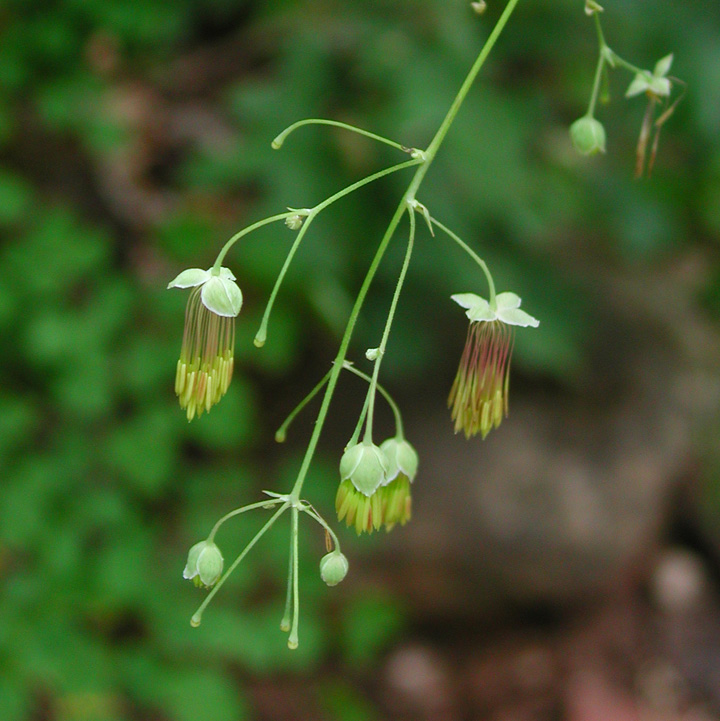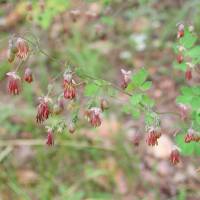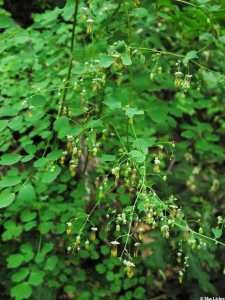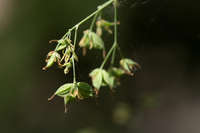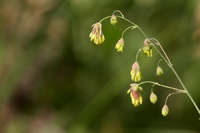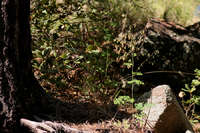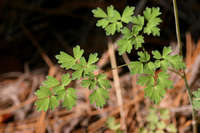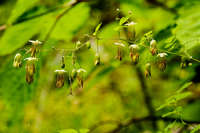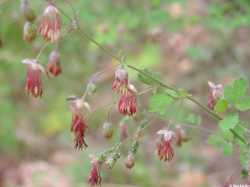Roots dark brown to ± black (when dry), fibrous. Stems mostly erect, sometimes reclining, (20-)30-60(-150) cm, glabrous, from rhizomes or branched caudices. Leaves mainly cauline, mostly short-petiolate. Leaf blade green, (2-)3-4×-ternately compound, membranous; leaflets obliquely orbiculate or nearly cordate, apically 3-lobed, (5-)10-20 × (6-)8-12(-18) mm wide, lobe margins crenate, surfaces abaxially often glandular. Inflorescences terminal and axillary, panicles, open and leafy, many flowered. Flowers: sepals whitish or greenish, in staminate flowers ovate to elliptic, 3-5 mm; in pistillate flowers ovate to rhombic or broadly lanceolate, 1.5-2 mm; filaments deep yellow or purplish, 4-7.5 mm; anthers 2.2-3.4 mm, apiculate with tip to 0.8 mm; stigma purplish. Achenes 7-11(-14), not reflexed, sessile to short-stipitate; stipe 0-2 mm; body oblanceolate to obliquely obovate-elliptic, strongly laterally compressed, (5-)9(-11) mm, glandular or glabrous, 3-4(-5)-veined on each side, veins ± parallel, converging toward ends (rarely branched or sinuous), not anastomosing-reticulate; beak 1.5-4 mm.
Flowering early-mid summer (Jun-Aug). Willow, birch, mountain brush, sagebrush-snowberry, boxelder-cottonwood, alder, ponderosa pine, lodgepole pine, aspen-tall forb, and spruce-fir communities; 1100-3300 m; Ariz., Calif., Colo., Idaho, Mont., Nev., N.Mex., Oreg., S.Dak., Tex., Utah, Wyo.; n Mexico.
The stems and achenes of Thalictrum fendleri are often purplish.
Decoctions prepared from the roots of Thalictrum fendleri were used medicinally by Native Americans to cure colds and gonorrhea, and in ceremonies (D. E. Moerman 1986).
Duration: Perennial
Nativity: Native
Lifeform: Forb/Herb
General: Perennial herb, 60-150 cm tall, from rhizomes or a branched caudex; stems erect or rarely reclining, leafy, glabrous.
Leaves: Alternate along the stems, on usually long petioles; leaves 3-4 times ternately compound (divided into 3 leaflets), the terminal leaflets on petiolules, with blades 1-2 cm long, round, with 3 shallow lobes and crenate margins.
Flowers: Green to yellow and nodding, in leafy panicles at the tops of the stems; male and female flowers are usually on different plants; sepals 4 per flower, ovate to lanceolate (female flowers) or elliptic (male flowers), light green and early-deciduous; petals absent; male flowers have dangling stamens with yellow filaments.
Fruits: Achenes 7-11 per flower; each achene 5 mm long, oblanceolate, flattened and asymmetric, with prominent longitudinal ribs from the base to the apex.
Ecology: Found in wetted areas among willows, birch, mountain brush, and boxelder cottonwood communities; also in pine forests, from 5,000-9,500 ft (1524-2896 m); flowers April-August.
Distribution: OR to SD, south to CA, AZ, NM, TX, and MEX.
Notes: This humble perennial herb is a common understory species in ponderosa pine forests; look for the many small round leaflets with shallow lobes and irregular teeth at the apex; the plant comes alive when in flower, with delicate, hanging stamens on the male flowers. It should be noted that the mature flowers sometimes turn dark red with age. The other Thalictrum in Arizona, T. dasycarpum, has stem leaves which are sessile or nearly so; the leaflets are usually longer than wide; and filaments are white (T. fendleri generally has leaflets slightly wider than long, and stamens with yellow filaments).
Ethnobotany: Used medicinally to treat colds, headaches, and gonorrhea; used extensively as a ceremonial medicine; some consider it to be poisonous to humans and animals.
Etymology: Thalictrum is from the Greek thaliktron, a name given by Dioscorides to describe another plant with divided leaves; fendleri is named for Augustus Fendler (1813-1883) a German plant collector.
Synonyms: Thalictrum amissum, T. fendleri var. platycarpum, T. fendleri var. wrightii
Editor: LCrumbacher 2011, AHazelton 2017


